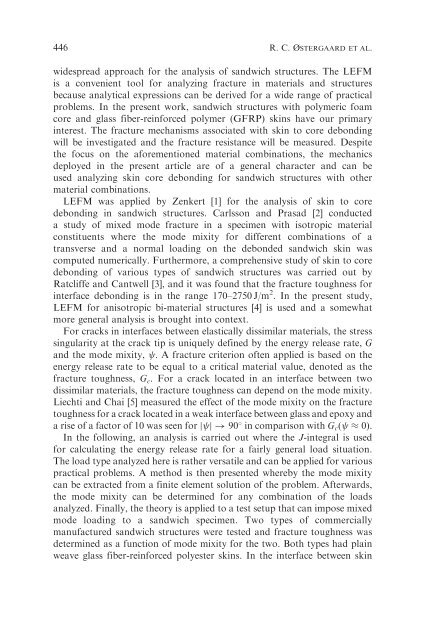Rasmus ÿstergaard forside 100%.indd - Solid Mechanics
Rasmus ÿstergaard forside 100%.indd - Solid Mechanics
Rasmus ÿstergaard forside 100%.indd - Solid Mechanics
You also want an ePaper? Increase the reach of your titles
YUMPU automatically turns print PDFs into web optimized ePapers that Google loves.
446 R. C. ØSTERGAARD ET AL.<br />
widespread approach for the analysis of sandwich structures. The LEFM<br />
is a convenient tool for analyzing fracture in materials and structures<br />
because analytical expressions can be derived for a wide range of practical<br />
problems. In the present work, sandwich structures with polymeric foam<br />
core and glass fiber-reinforced polymer (GFRP) skins have our primary<br />
interest. The fracture mechanisms associated with skin to core debonding<br />
will be investigated and the fracture resistance will be measured. Despite<br />
the focus on the aforementioned material combinations, the mechanics<br />
deployed in the present article are of a general character and can be<br />
used analyzing skin core debonding for sandwich structures with other<br />
material combinations.<br />
LEFM was applied by Zenkert [1] for the analysis of skin to core<br />
debonding in sandwich structures. Carlsson and Prasad [2] conducted<br />
a study of mixed mode fracture in a specimen with isotropic material<br />
constituents where the mode mixity for different combinations of a<br />
transverse and a normal loading on the debonded sandwich skin was<br />
computed numerically. Furthermore, a comprehensive study of skin to core<br />
debonding of various types of sandwich structures was carried out by<br />
Ratcliffe and Cantwell [3], and it was found that the fracture toughness for<br />
interface debonding is in the range 170–2750 J/m 2 . In the present study,<br />
LEFM for anisotropic bi-material structures [4] is used and a somewhat<br />
more general analysis is brought into context.<br />
For cracks in interfaces between elastically dissimilar materials, the stress<br />
singularity at the crack tip is uniquely defined by the energy release rate, G<br />
and the mode mixity, . A fracture criterion often applied is based on the<br />
energy release rate to be equal to a critical material value, denoted as the<br />
fracture toughness, Gc. For a crack located in an interface between two<br />
dissimilar materials, the fracture toughness can depend on the mode mixity.<br />
Liechti and Chai [5] measured the effect of the mode mixity on the fracture<br />
toughness for a crack located in a weak interface between glass and epoxy and<br />
a rise of a factor of 10 was seen for j j !90 in comparison with Gcð 0Þ:<br />
In the following, an analysis is carried out where the J-integral is used<br />
for calculating the energy release rate for a fairly general load situation.<br />
The load type analyzed here is rather versatile and can be applied for various<br />
practical problems. A method is then presented whereby the mode mixity<br />
can be extracted from a finite element solution of the problem. Afterwards,<br />
the mode mixity can be determined for any combination of the loads<br />
analyzed. Finally, the theory is applied to a test setup that can impose mixed<br />
mode loading to a sandwich specimen. Two types of commercially<br />
manufactured sandwich structures were tested and fracture toughness was<br />
determined as a function of mode mixity for the two. Both types had plain<br />
weave glass fiber-reinforced polyester skins. In the interface between skin
















